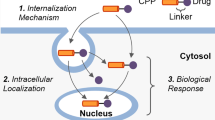Abstract
Purpose. To determine how restricted conformational flexibility of hexapeptides influences their cellular permeation characteristics.
Methods. Linear (Ac-Trp-Ala-Gly-Gly-X-Ala-NH2; X = Asp, Asn, Lys) and cyclic (cyclo[Trp-Ala-Gly-Gly-X-Ala]; X = Asp, Asn, Lys) hexapeptides were synthesized, and their transport characteristics were assessed using the Caco-2 cell culture model. The lipophilicities of the hexapeptides were determined using an immobilized artificial membrane. Diffusion coefficients used to calculate molecular radii were determined by NMR. Two-dimensional NMR spectroscopy, circular dichroism, and molecular dynamic simulations were used to elucidate the most favorable solution structure of the cyclic Asp-containing peptide.
Results. The cyclic hexapeptides used in this study were 2−3 times more able to permeate (e.g., Papp = 9.3 ± 0.3 × 10−8 cm/sec, X = Asp) the Caco-2 cell monolayer than were their linear analogs (e.g., Papp = 3.2 ± 0.3 × 10−8 cm/sec, X = Asp). In contrast to the linear hexapeptides, the flux of the cyclic hexapeptides was independent of charge. The cyclic hexapeptides were shown to be more lipophilic than the linear hexapeptides as determined by their retention times on an immobilized phospholipid column. Determination of molecular radii by two different techniques suggests little or no difference in size between the linear and cyclic hexapeptides. Spectroscopic data indicate that the Asp-containing linear hexapeptide exists in a dynamic equilibrium between random coil and β-turn structures while the cyclic Asp-containing hexapeptide exists in a well-defined compact amphophilic structure containing two β-turns.
Conclusions. Cyclization of the linear hexapeptides increased their lipophilicities. The increased permeation characteristics of the cyclic hexapeptides as compared to their linear analogs appears to be due to an increase in their flux via the transcellular route because of these increased lipophilicities. Structural analyses of the cyclic Asp-containing hexapeptide suggest that its well-defined solution structure and, specifically the existence of two β-turns, explain its greater lipophilicity.
Similar content being viewed by others
REFERENCES
N. C. Wrighton, F. X. Farrell, R. Chang, A. K. Kashyap, F. P. Barbone, L. S. Mulcahy, D. L. Johnson, R. W. Barett, L. K. Jolliffe, and W. J. Dower. Science 273:397–544 (1996).
G. M. Pauletti, S. Gangwar, G. T. Knipp, M. M. Nerurkar, F. W. Okumu, K. Tamura, T. J. Siahaan, and R. T. Borchardt. J. Controlled Release 41:3–17 (1996).
V. H. L. Lee, R. D. Traver, and M. E. Taub. in: V. H. L. Lee (ed.), Peptide and Protein Drug Delivery, Marcel Dekker, New York, 1991, pp. 303–357.
M. J. Humphrey. in: S. S. Davis, L. Illum and E. Tomlinson (eds.), Delivery Systems for Peptide Drugs, Plenum Press, New York, 1986, pp. 139–151.
X. H. Zhou. J. Controlled Release 29:239–252 (1994).
J. P. Yevich. in: P. Krogsgaard-Larsen and H. Bundgaard (eds.), A Textbook of Drug Design and Development, Harwood Academic Publishers, Langhorne, 1991, pp. 606–630.
R. A. Conradi, P. S. Burton, and R. T. Borchardt. in: V. Pliska, B. Testa and H. Van de Waterbeemd (eds.), Lipophilicity in Drug Action and Toxicology, VCH, Weinheim, 1996, pp. 233–250.
R. A. Conradi, A. R. Hilgers, N. F. H. Ho, and P. S. Burton. Pharm. Res. 9:435–439 (1992).
P. S. Burton, R. A. Conradi, A. R. Hilgers, N. F. H. Ho, and L. L. Maggiora. J. Controlled Release 19:87–93 (1992).
J. Drewe, G. Fricker, J. Vonderscher, and C. Beglinger. Br. J. Pharmacol. 108:298–303 (1993).
S. Lundin and P. Artursson. Int. J. Pharm. 64:181–186 (1990).
D. T. Thwaites, B. H. Hirst, and N. L. Simmons. Pharm. Res. 10:674–681 (1993).
G. M. Pauletti, F. W. Okumu, and R. T. Borchardt. Pharm. Res. 14:169–175 (1997).
G. T. Knipp, N. F. H. Ho, C. L. Barsuhn, and R. T. Borchardt. Pharm. Res. 12:S-302 (1995).
A. Adson, T. J. Raub, P. S. Burton, C. L. Barsuhn, A. R. Hilgers, K. L. Audus, and N. F. H. Ho. J. Pharm. Sci. 83:1529–1536 (1994).
D. Barlow and T. Satoh. J. Controlled Release 29:283–291 (1994).
I. J. Hidalgo, T. J. Raub, and R. T. Borchardt. Gastroenterology 96:736–749 (1989).
G. M. Pauletti, S. Gangwar, F. W. Okumu, T. J. Siahaan, V. J. Stella, and R. T. Borchardt. Pharm. Res. 13:1615–1623 (1996).
H. Rink. Tetrahedron Lett. 28:3787–3790 (1987).
G. Lu, S. Mojsov, J. P. Tam, and R. B. Merrifield. J. Org. Chem. 46:3433–3436 (1981).
J. Diago-Meseguer and A. L. Palomo-Coll. Synthesis 1980:547–551 (1980).
S. Gangwar, S. D. S. Jois, T. J. Siahaan, D. G. Vander Velde, V. J. Stella, and R. T. Borchardt. Pharm. Res. 13:1655–1660 (1996).
G. M. Pauletti, S. Gangwar, B. Wang, and R. T. Borchardt. Pharm. Res. 14: 11–17 (1997).
R. W. Woody. in: V. J. Hruby (ed.), The Peptides, Academic Press, New York, 1985, pp. 15–114.
K. Wüthrich, NMR of Proteins and Nucleic Acids, John Wiley & Sons, New York (1986).
V. F. Bystrov. Progr. NMR Spectrosc. 10:41–81 (1976).
K. D. Fine, C. A. Santa Ana, J. L. Portes, and J. S. Fordtran. Gastroenterology 108:983–989 (1995).
F. W. Okumu, G. M. Pauletti, D. G. Vander Velde, T. J. Siahaan, and R. T. Borchardt. Pharm. Res. 12:S-302 (1995).
G. M. Pauletti, F. W. Okumu, D. G. Vander Velde, and R. T. Borchardt. Pharm. Res. 13:S-235 (1996).
J. Hochman and P. Artursson. J. Controlled Release 29:253–267 (1994).
J. R. Pappenheimer and K. Z. Reiss. J. Memb. Biol. 100:123–136 (1987).
Rights and permissions
About this article
Cite this article
Okumu, F.W., Pauletti, G.M., Vander Velde, D.G. et al. Effect of Restricted Conformational Flexibility on the Permeation of Model Hexapeptides Across Caco-2 Cell Monolayers. Pharm Res 14, 169–175 (1997). https://doi.org/10.1023/A:1012092409216
Issue Date:
DOI: https://doi.org/10.1023/A:1012092409216




